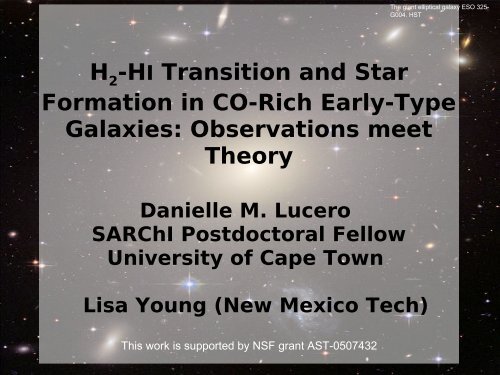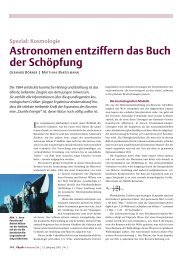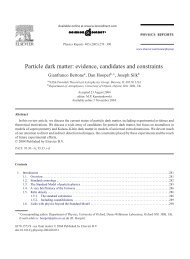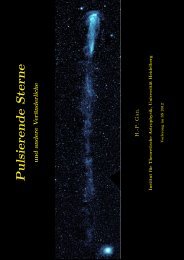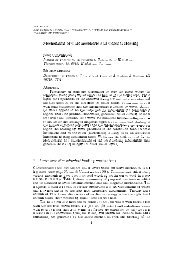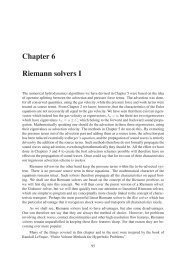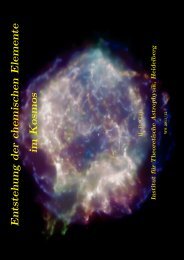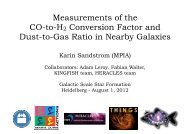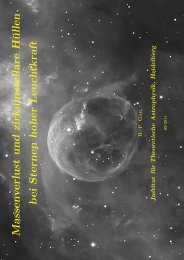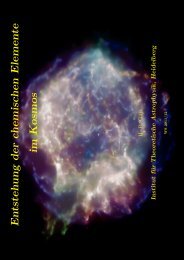The HI-H 2 Transition and Star Formation in Early-Type Galaxies
The HI-H 2 Transition and Star Formation in Early-Type Galaxies
The HI-H 2 Transition and Star Formation in Early-Type Galaxies
Create successful ePaper yourself
Turn your PDF publications into a flip-book with our unique Google optimized e-Paper software.
<strong>The</strong> giant elliptical galaxy ESO 325-<br />
G004. HST<br />
H -<strong>HI</strong> <strong>Transition</strong> <strong>and</strong> <strong>Star</strong><br />
2<br />
<strong>Formation</strong> <strong>in</strong> CO-Rich <strong>Early</strong>-<strong>Type</strong><br />
<strong>Galaxies</strong>: Observations meet<br />
<strong>The</strong>ory<br />
Danielle M. Lucero<br />
SARChI Postdoctoral Fellow<br />
University of Cape Town<br />
Lisa Young (New Mexico Tech)<br />
This work is supported by NSF grant AST-0507432<br />
1
Motivation<br />
<br />
It is well known that many early-type galaxies (E <strong>and</strong> S0) conta<strong>in</strong> significant amounts of<br />
cold gas <strong>and</strong> detectable star formation<br />
<br />
(e.g. Wikl<strong>in</strong>d et al. 1995; Young 2002; Welch & Sage 2003; Sage & Welch 2006;<br />
Morganti et al. 2006; Sage et al. 2007; Combes et al. 2007; Osterloo et al. 2007;<br />
Alighieri et al. 2007; Welch et al. 2010; Serra et al. 2011, Young et al 2011).<br />
<br />
ATLAS 3 D ! ----> Multi-wavelength observations of a statistically well def<strong>in</strong>ed sample of<br />
260 early-type galaxies derived from the 2MASS all sky survey (out to 42 Mpc; M K<br />
≤21.5).<br />
<br />
<br />
<strong>HI</strong> (WSRT 45’’) <strong>and</strong> CO (CARMA 5’’) maps.<br />
<strong>HI</strong> maps at too low a resolution to study radial comparisons of H 2<br />
versus <strong>HI</strong>.<br />
2
Motivation<br />
<br />
It is well known that many early-type galaxies (E <strong>and</strong> S0) conta<strong>in</strong> significant amounts of<br />
cold gas <strong>and</strong> detectable star formation.<br />
<br />
<strong>The</strong> evolutionary pathway of early-type galaxies is thought to be driven <strong>in</strong> part by the<br />
acquisition <strong>and</strong> transformation of this cold gas <strong>in</strong>to new stars. To the best of our<br />
knowledge stars form only from the molecular gas phase. Clearly, knowledge of the<br />
amount of cold gas <strong>in</strong> the molecular phase versus the atomic phase is an important<br />
constra<strong>in</strong>t for theoretical models of star formation <strong>and</strong> galaxy evolution.<br />
<br />
Use the cold gas k<strong>in</strong>ematics <strong>and</strong> gas morphologies to look for orig<strong>in</strong>s for the <strong>HI</strong> <strong>and</strong> CO<br />
(Lucero & Young Submitted).<br />
<br />
Test theoretical <strong>and</strong> empirical models of star formation known for spirals. Is there<br />
evidence of star formation where star formation models predict it to occur?<br />
<br />
Test theoretical <strong>and</strong> empirical models of molecule formation observed for spirals.<br />
3
Sample <strong>and</strong> Observations<br />
Eleven of the most CO-rich early-types (MH2 6x10 8 -5x10 9 M sol<br />
).<br />
A range of morphologies (6 S0, <strong>and</strong> 5 E), distances (up to 80 Mpc), environments<br />
(field/cluster/group), <strong>and</strong> optical lum<strong>in</strong>osities (-21.7 ≤ MB ≥ -18.3).<br />
All sample galaxies have R1/4 classifications as E, E/S0 or S0 <strong>in</strong> several catalogs.<br />
Prior knowledge of amount <strong>and</strong> location of star formation for all sample galaxies<br />
(Young, Bendo, Lucero 2009; Lucero & Young 2007).<br />
<strong>HI</strong> VLA C array data (15’’) are compared to the exist<strong>in</strong>g CO maps (7’’). <strong>HI</strong><br />
observations have 2 to 16 times better resolution than the current <strong>HI</strong> surveys (e.g.<br />
ATLAS 3D). Lucero & Young Submitted.
Results<br />
NGC 807<br />
<br />
Five Detections: NGC 3656, NGC<br />
5666, NGC 807, NGC 3032, <strong>and</strong><br />
UGC 1503 (2 E’s <strong>and</strong> 4 lenticulars).<br />
<br />
One marg<strong>in</strong>ally detected <strong>in</strong> the VLA<br />
data: NGC 4150.<br />
<br />
NGC 2320 has an narrow absorption<br />
feature redshifted ~60 km/s with<br />
respect to the systemic velocity.<br />
Lucero & Young Submitted<br />
<br />
Four non-detections<br />
(< few x10 19 cm -2 ): NGC 83, NGC<br />
4476, NGC 4526 NGC 4459. All are<br />
cluster/group galaxies.<br />
5
NGC 5666 NGC 807 NGC 3656<br />
peak <strong>HI</strong> surface density is 9.1x10 20<br />
cm −2<br />
peak <strong>HI</strong> surface density is 7.7x10 20 cm −2<br />
peak <strong>HI</strong> surface density is 7.2x10 21 cm −2<br />
Morganti et al. 2006<br />
NGC 3032<br />
NGC 4150 UGC 1503<br />
peak <strong>HI</strong> surface density is 2.9x10 19 cm −2<br />
Peak <strong>HI</strong> surface density is 1.3x10 21 cm −2<br />
peak <strong>HI</strong> surface density is 9.9x10 20 cm −2<br />
6
<strong>HI</strong> detected<br />
<strong>HI</strong> non-detected<br />
UGC 1503<br />
NGC 4476<br />
NGC 5666<br />
NGC 4526<br />
NGC 3032<br />
Young, Bendo, Lucero<br />
NGC 4459<br />
7
Σtot, ΣH2, Σ<strong>HI</strong> Versus Radius<br />
RCO<br />
15”<br />
RCO<br />
7”<br />
Green: <strong>HI</strong> surface density<br />
Black: H2 surface density<br />
Orange: <strong>HI</strong>+H2 surface density<br />
• Σ<strong>HI</strong> does not saturate above 9-10 M⨀ pc -2 for<br />
any of the sample galaxies.<br />
RCO<br />
15”<br />
RCO<br />
15”<br />
• Σ<strong>HI</strong> saturation occurs near RCO except for<br />
NGC 3032.<br />
• NGC 4150 has extremely low Σ<strong>HI</strong> throughout.<br />
RCO<br />
15”<br />
50”<br />
• Field E’s (NGC 807, UGC 1503) saturate at<br />
~5 M⨀ pc -2 whereas the field S0’s (NGC 3032,<br />
NGC 3656, NGC 5666) saturate at ~9-10 M⨀<br />
pc -2 .<br />
RCO<br />
Morphological correlation or resolution<br />
effects?.<br />
8
Σcrit Versus Σtot<br />
<strong>The</strong> Molecular Fraction: <strong>HI</strong> Detected <strong>Early</strong>-<strong>Type</strong>s<br />
------ Krumholz et al. 2009 model<br />
Model assumptions:<br />
ζ’t=G’0<br />
Z=1.0<br />
Z=1.7<br />
Z’d=Z’g=Z’<br />
May not hold <strong>in</strong> <strong>Early</strong>-<strong>Type</strong>s<br />
Fit Paramaters:<br />
Z=5 Z=1.3<br />
Log 10<br />
(Z)== -0.2 to 0.4<br />
(e.g. Kuntschner et al. 2010)<br />
ϕ mol<br />
=10; ϕ CNM<br />
~10<br />
NGC 3032 <strong>and</strong> NGC 4150: High F mol<br />
at low Σ tot<br />
Z=17 Z=1.0<br />
Both galaxies show <strong>in</strong>dications of recent<br />
<strong>in</strong>teractions or gas accretion!<br />
10
Rmol-Pressure Relation<br />
Recall that Elmegreen’s (1993) model predicts:<br />
• Several studies of the <strong>HI</strong> <strong>and</strong> H2 maps of nearby spiral galaxies f<strong>in</strong>d that the<br />
molar fraction, Rmol, is a tight function of the midplane hydrostatic pressure (Blitz<br />
& Rosolowsky 2004, 2006; Leroy et al. 2008)<br />
• Blitz & Roslolowsky (2006) specifically f<strong>in</strong>d:<br />
where<br />
• <strong>The</strong> j(Z) dependence is assumed to be subsumed <strong>in</strong>to this empirical<br />
relationship.<br />
11
Blitz & Rosolowsky 2006; Leroy et al. 2008<br />
ρs is constant over Hg.<br />
Hs>>Hg.<br />
Azimuthal symmetry<br />
σg=10 km s -1<br />
12
Blitz & Rosolowsky 2006; Leroy et al. 2008<br />
ρs is constant over Hg.<br />
Hs>>Hg.<br />
Azimuthal symmetry<br />
σg=10 km s -1<br />
ρs>>ρg.<br />
13
ρs is constant over Hg?<br />
Hs<br />
>>Hg (?)<br />
Azimuthal symmetry<br />
σ<br />
g(R)=?<br />
ρs>>ρg?<br />
?<br />
14
ρs is constant over Hg?<br />
s>>Hg<br />
H<br />
Koyama & Ostriker (2009) derive an approximate solution of<br />
the equations of hydrodynamic equilibrium us<strong>in</strong>g a 2 nd order<br />
Taylor series expansion.<br />
Azimuthal symmetry<br />
σ<br />
g(R)=?<br />
ρs>>ρg?<br />
?<br />
15
ρs is constant over Hg?<br />
Hs<br />
>>Hg (?)<br />
• Numerically this approximate solution gives better estimates than the<br />
Blitz & Rosolowsky (2006) formalism.<br />
ρg/ρs = 4 produces results only 10% off the ”proper” numerical<br />
<strong>in</strong>tegration whereas the Blitz & Rosolowsky (2006)<br />
approximation is off by about 20% to 30%.<br />
Azimuthal symmetry<br />
σ<br />
g(R)=?<br />
ρs>>ρg?<br />
Koyama & Ostriker 2009<br />
16
ρs is constant over Hg?<br />
s>>Hg<br />
H<br />
Azimuthal symmetry<br />
σg(R)=<br />
10 km/s<br />
ρs>>ρg?<br />
Koyama & Ostriker 2009<br />
17
Multi-Gaussian (MGE) Stellar Density<br />
• <strong>The</strong> 3D stellar density, ρs(R,0), is determ<strong>in</strong>ed us<strong>in</strong>g a multi-Gaussian<br />
expansion (MGE) fit developed by Cappellari (2002) to 2μ All Sky Survey<br />
(2MASS) Ks-b<strong>and</strong> ATLAS images (Skrutskie et al. 2006) or UKIDSS K-b<strong>and</strong><br />
images if available.<br />
<br />
Characterizes the observed surface brightness as a sum of Gaussians,<br />
<strong>and</strong> allows the photometry to be reproduced <strong>in</strong> detail.<br />
Requires an <strong>in</strong>cl<strong>in</strong>ation for deprojection.<br />
<br />
Estimated from optical dust images.<br />
Requires azimuthal symmetry.<br />
Most of the early-type sample galaxies are oblate/fast rotators.<br />
Doesn't require an assumed stellar scale height.
ρ s<br />
Constant with H g<br />
?<br />
<strong>The</strong> MGE stellar density versus radius for several different scale heights.<br />
Hs=0 pc, 150 pc, 300 pc above the midplane.<br />
YES!<br />
Local Milky Way ρs<br />
19
ρs is constant over Hg<br />
Hs<br />
>>Hg (?)<br />
Azimuthal symmetry<br />
σg(R)=<br />
10 km/s<br />
20
Koyama & Ostriker 2008 ----><br />
Hg: 5-10 pc <strong>in</strong> the<br />
<strong>in</strong>ner regions to<br />
Hg: 40-340 pc <strong>in</strong> the<br />
outer regions.<br />
21
Koyama & Ostriker 2008 ----><br />
22<br />
Red: Range <strong>in</strong> MGE ρs<br />
dash-dot: Inferred ρg<br />
dotted: Inferred ρg from<br />
average Σg<br />
22
Koyama & Ostriker 2008 ----><br />
23<br />
Gas self gravity is important!<br />
Red: Range <strong>in</strong> MGE ρs<br />
dash-dot: Inferred ρg<br />
dotted: Inferred ρg from<br />
average Σg<br />
23
Koyama & Ostriker 2008 ----><br />
24
Rmol-Pressure Relation<br />
•<strong>Early</strong>-type empirical result: P=[(P/k B<br />
)/5200±400 K cm -3 )] 0.45±0.09<br />
•<strong>The</strong> Elmegreen (1993) prediction, F mol<br />
≈P 2.2 j(Z) -1 , is only good for R mol<br />
Rmol-Pressure Relation<br />
•<strong>Early</strong>-type empirical result: P=[(P/k B<br />
)/52±4 K cm -3 )] 0.45±0.09<br />
•<strong>The</strong> Elmegreen (1993) prediction, F mol<br />
≈P 2.2 j(Z) -1 , is only good for R mol<br />
1 results <strong>in</strong> a much more shallow fitted<br />
• R mol<br />
=P1.2 for R mol<br />
Summary<br />
• Observed <strong>HI</strong> surface density saturation <strong>and</strong> total surface density at the<br />
transition region are similar to that of early-type galaxies.<br />
• <strong>The</strong> Krumholz et al. (2009) dissociation models do a fair job of predict<strong>in</strong>g the<br />
molecular fraction <strong>in</strong> CO-rich early-type galaxies.<br />
• <strong>The</strong> cold gas systems of CO-rich early-type<br />
galaxies fundamentally resemble that of normal<br />
• Stability spiral models galaxies! are more or less consistent with observations. <strong>Star</strong> formation<br />
is occurr<strong>in</strong>g where we predict it to occur except where the gas is likely not yet<br />
settled <strong>in</strong>to the disk.<br />
• R mol<br />
is a much more shallow function of hydrostatic midplane pressure than<br />
observed for disk galaxies.
<strong>The</strong> Molecular Fraction: Resolution Effects<br />
Black pluses: total gas surface density<br />
(correct for <strong>in</strong>cl<strong>in</strong>ation <strong>and</strong> the present<br />
of helium)<br />
+ 7 arcsec <strong>HI</strong> <strong>and</strong> CO maps<br />
+ <strong>HI</strong> <strong>and</strong> CO maps smoothed to 15<br />
arcsec resolution<br />
+ 7 arcsec CO map <strong>and</strong> <strong>HI</strong> maps<br />
smoothed to 15 arcsec<br />
Dash-dot l<strong>in</strong>e: Elmegreen 1993 photodissociation<br />
model with U0=Z0=1<br />
Robust to Resolution!<br />
28


